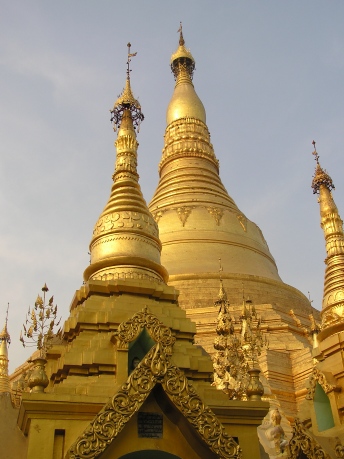Ein Hti (ausgesprochen "ti") ist ein charakteristisches architektonisches Element, das die Spitze vieler Pagoden und Stupas in Myanmar (Burma) ziert. Es handelt sich um einen kunstvoll gestalteten Schirm oder eine kronenähnliche Spitze, der sowohl religiöse als auch künstlerische Bedeutung hat. Das Hti ist ein Symbol für die Verbindung zwischen Himmel und Erde und spielt eine wichtige Rolle in der buddhistischen Architektur Myanmars.
Wichtige Merkmale eines Hti:
-
Design und Struktur:
-
Ein Hti besteht typischerweise aus mehreren konzentrischen Ringen, die oft mit Gold oder anderen Metallen überzogen sind.
-
Es ist mit Glocken, Edelsteinen und verzierten Metallstreben geschmückt, die im Wind klingen und als Gebete an den Himmel gelten.
-
Die Spitze des Hti ist oft mit einem Juwel oder einem Diamanten verziert, der die Erleuchtung symbolisiert.
-
-
Religiöse Bedeutung:
-
Das Hti repräsentiert den Weltenberg Meru, ein zentrales Symbol in der buddhistischen Kosmologie, der als Achse des Universums gilt.
-
Es symbolisiert auch den Schirm des Buddha, der Schutz und Segen spendet.
-
-
Kulturelle Bedeutung:
-
Das Hti ist ein wichtiges Symbol des buddhistischen Glaubens in Myanmar und zeigt die Handwerkskunst und künstlerische Tradition des Landes.
-
Viele berühmte Pagoden, wie die Shwedagon-Pagode in Yangon oder die Ananda-Pagode in Bagan, sind für ihre prächtigen Hti bekannt.
-
-
Rituale und Zeremonien:
-
Die Installation eines Hti auf einer Pagode ist ein feierliches Ereignis, das oft mit großen religiösen Zeremonien verbunden ist.
-
Gläubige spenden oft Gold oder Edelsteine, um zur Verschönerung des Hti beizutragen.
-
Berühmte Pagoden mit beeindruckenden Hti:
-
Shwedagon-Pagode (Yangon):
-
Das Hti der Shwedagon-Pagode ist mit über 5.000 Diamanten und 2.000 Edelsteinen besetzt und gilt als eines der prächtigsten in Myanmar.
-
-
Ananda-Pagode (Bagan):
-
Das Hti der Ananda-Pagode ist ein Meisterwerk der birmanischen Architektur und spiegelt die Eleganz der Bagan-Periode wider.
-
-
Kyaiktiyo-Pagode (Goldener Felsen):
-
Das Hti auf dem Goldenen Felsen ist ein Symbol für das Gleichgewicht zwischen Natur und Spiritualität.
-
Warum ist das Hti wichtig?
-
Künstlerische Meisterschaft: Die Herstellung eines Hti erfordert großes handwerkliches Geschick und ist ein Ausdruck der kulturellen Identität Myanmars.
-
Spirituelle Symbolik: Es verbindet die irdische Welt mit dem Göttlichen und erinnert an die buddhistischen Lehren.
-
Touristische Attraktion: Die prächtigen Hti sind ein Highlight für Besucher und Fotografen.
Interessante Fakten:
-
Das Hti der Shwedagon-Pagode wiegt mehrere Tonnen und wurde im Laufe der Jahrhunderte immer wieder mit neuen Edelsteinen und Gold verziert.
-
In Myanmar gibt es spezialisierte Handwerker, die sich auf die Herstellung und Restaurierung von Hti konzentrieren.
Wenn Sie Myanmar besuchen, achten Sie auf die kunstvollen Hti der Pagoden – sie sind nicht nur architektonische Meisterwerke, sondern auch ein Symbol für die tiefe Spiritualität des Landes
An Hti (pronounced "htee") is a significant and symbolic ornament used in Buddhist culture, particularly in Myanmar. It is a type of decorative finial, often found atop Buddhist pagodas and stupas.
Key Features of the Hti:
-
Structure and Appearance:
- The Hti is typically a multi-tiered umbrella-like structure that is placed at the pinnacle of a pagoda, temple, or stupa.
- It often consists of several concentric rings or levels that resemble a lotus flower or a palace canopy, and it is adorned with decorative elements like gold leaf, gems, or precious metals.
- The central part of the Hti may include a golden or jeweled ornament symbolizing spiritual protection and enlightenment.
-
Symbolism:
- The Hti is a powerful Buddhist symbol representing protection, spiritual elevation, and divine presence. It is seen as a protective canopy that shields the Buddha or the sacred space beneath it.
- The multi-tiered structure symbolizes the Buddha's teachings, and its upward shape is said to represent the spiritual ascent of the practitioner toward nirvana (enlightenment).
- The Hti is also associated with royalty and the divine. It can be seen as a royal umbrella that signifies the protection and reverence of the sacred Buddha or holy relics.
-
Placement and Usage:
- The Hti is usually placed on the top of large pagodas and stupas as a sign of reverence and to signify the importance of the structure. It is considered a blessed offering that enhances the sanctity of the pagoda.
- It is often used during special Buddhist ceremonies and festivals, such as the Tazaungdaing Festival, where offerings and acts of merit are made to honor the Buddha.
-
Cultural Importance:
- The Hti plays an important role in Burmese Buddhist architecture and is a symbol of the unity of the community and respect for the Buddha's teachings.
- It is often used as a mark of royal or spiritual authority. For example, the Hti atop the Shwedagon Pagoda in Yangon, Myanmar, is a famous and important symbol of both the Buddhist faith and Myanmar's cultural heritage.
In conclusion, the Hti is a beautiful and meaningful religious object that serves to highlight the spiritual significance of pagodas and temples in Myanmar, and it is an important element of the country’s Buddhist tradition.





